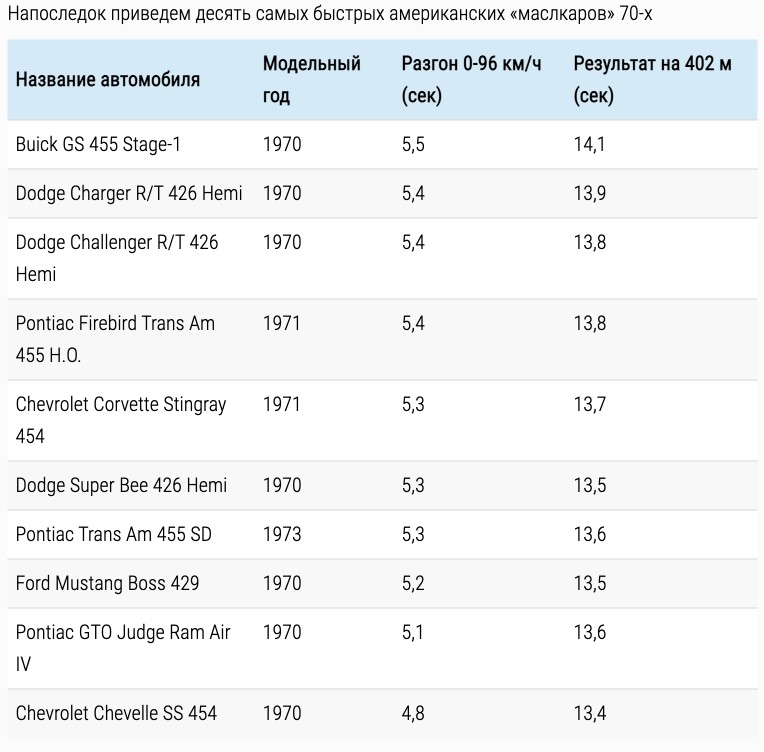The fastest classic muscle cars of the golden era (11 photos + 1 video)
To begin with, there will be a lot of controversy about this list of the most fast muscle cars of the 1960s and 1970s. This list of the fastest classic muscle cars was compiled based on available information about acceleration time from 0 to 60 mph for real factory cars that people could buy at the dealership. 
The late 1960s and early 1970s can be considered the zenith of an era "muscle cars" (muscle cars - translated from English "muscular" cars). At that time, American automakers were producing real monsters equipped with powerful V8 engines, inefficient drum brakes and ancient spring suspension. But these cars overclocked well and for most buyers this was enough. About how fast American muscle cars really are, we we will tell in this article.
Dodge Super Bee 426 Hemi 
The Dodge Super Bee was produced in a limited edition from 1969 to 1971. The car was created in defiance of the Plymouth Road Runner, which used stable demand, as it had excellent performance at relatively low price.
The Super Bee was based on a slightly lengthened Dodge Coronet chassis, and in the basic version was equipped with a 325-horsepower V8 engine with a volume of 6.3 l. Not a hefty power was reinforced by the aggressive appearance of a two-door body with functional air intakes on the hood and sports liveries on hind wings. In addition to the junior motor, buyers could choose a monstrous 440 Six Pack with a volume of 7.2 liters and a power of 390 hp. or, oh horror, racing 7-liter Hemi 426 engine with 425 hp To at least to somehow cope with this motor on the Super Bee, a torsion bar was used front suspension, rear axle with Dana Sure Grip differential and Goodyear sports tyres.
The dynamic data of the Dodge Super Bee 426 Hemi was as follows: from 0 to 96 km / h the car accelerated in 5.3 seconds, and a quarter mile overcame in just 13.5 seconds. Bad performance even in today's times!
Pontiac Trans Am 455 SD 
Pontiac Firebird Trans Am 455 SD is the latest nugget the golden era of American muscle cars. The car appeared in 1973, when a serious crisis was already brewing in the American auto industry, driven by rising fuel costs and new environmental standards.
Under the hood of this car, there was a rather interesting technically, the engine is called SD-455. The SD prefix in this case meant Super Duty, that is, the motor was designed for operation in harsh conditions. Among its features is a reinforced thick-walled block cylinders, cast crankshaft, forged connecting rods and forged pistons. Despite the relatively low compression ratio (8.4:1) from the working volume of 7.4 liters, Pontiac engineers managed to remove 310 hp. Enough an impressive result, given the trends of the new "weak" era. 
In addition to the engine, the Trans Am 455 SD boasted a well-tuned chassis with front spring suspension and stabilizers on both axles, front disc brakes and rack and pinion steering.
In 4-speed manual transmission configuration, up to 96 km / h Trans Am accelerated in 5.3 seconds, and the “quarter” passed in 13.6 seconds. For a car weighing 1700 kg, these were excellent indicators.
Ford Mustang Boss 429 
Ford Mustang Boss 429 was created for the sole purpose of homologation Ford 429 Nascar engine. In the racing version, this 7-liter the motor gave out more than 600 hp. and fought on equal terms with Chrysler bolides with 426 Hemi engines. However, for the civilian market, engine power prudently cut down to 375 hp.
Boss 429 engine was powered by a 1969 Ford Mustang of the year. However, in the engine compartment of this modest pony car, such an impressive unit without serious alterations did not fit under any circumstances. The problem was solved by brute force, brazenly crushing glasses body and cutting in place some elements of the body. 
A large and heavy engine on a relatively light Mustang looked rather absurd and even dangerous. The car had a pronounced understeer, slowed down badly and generally could only go, which is in a straight line. But it accelerated superbly: from 0-96 km / h Mustang Boss 429 accelerated in 5.2 seconds, and he drove 402 m in 13.4 seconds, on output accelerating to 162 km / h! For such characterssticks forgave the car poor handling, and a limited edition of 1358 copies, turned the 429th Mustang into a real collector's item.
Pontiac GTO Judge Ram Air IV 
In 1969, the legendary Pontiac GTO, the father of all muscle cars, received another restyling. Updated exterior and interior car, but the main thing in the list of options is a new package performance under the harsh name - Judge (Judge). Set $322 included a modified 7-liter 366 hp Ram Air engine, heavy duty suspension and sports dampers, 14″ steel rims and wide tires Goodyear polyglas. Without fail, the car received a bright coloring with stripes around the perimeter of the body. 
Judge turned out to be very successful and GTO used this package popularity. However, for special connoisseurs, there was one more modification with the designation Ram Air IV. In this version, the engine already developed 370 hp, and was equipped exclusively with a 4-speed manual transmission with close gear ratios. Besides lovers of "hot" starts, could optionally install a gearbox with increased gear ratio of 4.33:1, instead of the standard 3.90:1.
All this allowed the Pontiac GTO Ram Air IV from 0 to 96 km / h accelerate in just 5.1 seconds, and overcome a standard drag strip in 13.6 sec. - naturally, if the driver has the necessary skills, because few people in the USA knew how to operate a manual gearbox.
Chevrolet Chevelle SS454 
All the above "muscle cars" fade before the great and terrible Chevrolet Chevelle SS 454 second generation. This car appeared in 1970, and became the apogee of the development of classic American sports cars. The Chevrolet firm managed to release on the roads a common use a real monster with a power of 450 hp!
The greatness of the Chevelle SS was built around its great engine Chevrolet LS-6. This engine has been engineered to perfection. construction of racing engines of those years. It was a big-block unit with cast iron cylinder block, progressive cylinder head with hemispherical chambers combustion, forged pistons, steel crankshaft and racing camshaft. In addition, it was equipped with a high-performance 4-barrel Holley carburetor and aluminum intake manifold. To to tame all this power, the Chevelle chassis was significantly strengthened - they installed stiffer springs, disc brakes and a powerful stabilizer on front axle. As in the case of the Pontiac GTO Judge Ram Air, "Shevel" equipped with a 4-speed manual transmission and an optional racing gearbox 4.10:1. 
According to the dynamic data, the 454th Shevel was head and shoulders above its own competitors. The mark of 60 miles / hour (96 km / h) he overcame in 4.8 sec., and the "quarter" passed in 13.4 seconds. And at the output, its speed reached 170 km / h - a damn fast car for those times!
The fastest American "muscle cars" 





















